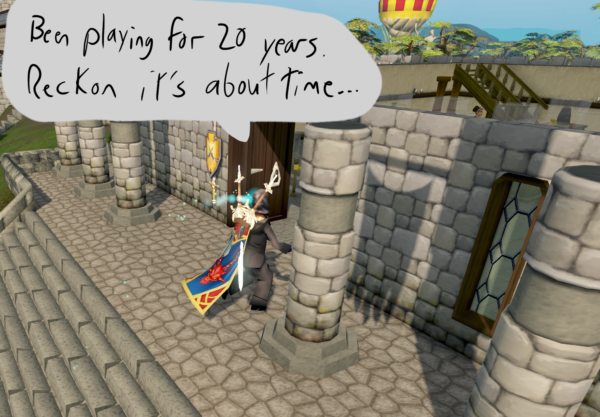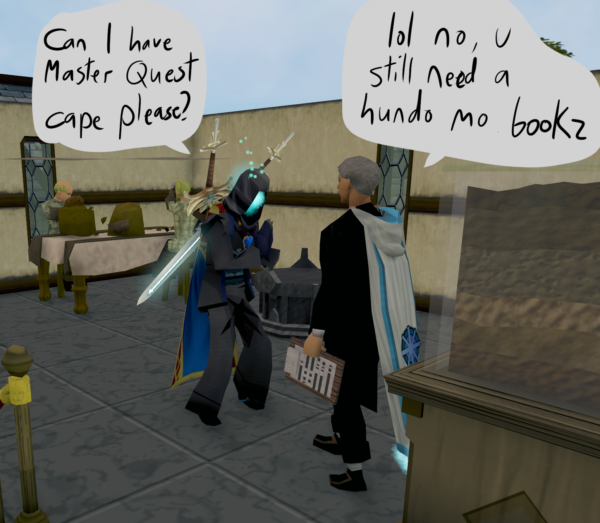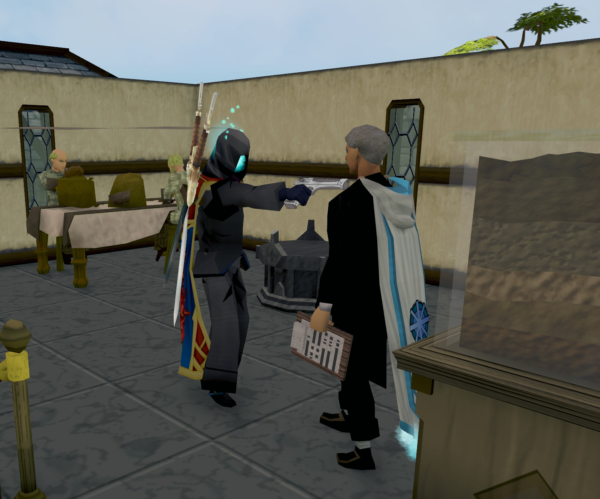Alex’s Analysis – 20 Years of Quests
posted by Alex 43 on 9th January 2021, at 3:15amRunescape’s 20 years old now. Started in 2001, and now it’s 2021. That’s 20 years of quests and lore and development and immersion into a vast populated game world. A world that is full of quests! And man, do I have stories to tell about the stories in this story-based game!
As a guy who’s done all the quests and gotten my Quest Cape, the majority of them done the day of release, I will…
… wait, hang on one sec. I can’t talk about quests looking like this. I need to make myself properly tangible! One sec while I get myself properly geared up…




Right. Anyways…
As a guy who’s properly and legitimately earned his MASTER Quest Cape, I’m going to talk about the 20 year evolution of quests in Runescape! Because yup, the quests of Runescape have an evolutionary process beyond their story. It’s not just the advancement of events and the game world, but also that of the storytelling capabilities of the folks at Jagex. I’ve been playing the game for 20 years, and I’ve watched the company grow from a simple Java-based garage-built game to an entire company that can afford their employees daily fresh fruit and health care.
And what a ride it was.
Let’s go back to the days of Runescape Classic and the original few quests. Cook’s Assistant, Sheep Shearer, Doric’s Quest, and Romeo and Juliet. These are some of the most classic of quests the game’s got. The years have seen many overhauls and updates to these quests; callbacks, reworkings, and even entire substitutions. But at their roots; they were the most simplest of quests.
Cook’s Assistant involved you giving egg, flour, and milk to a cook. Sheep Shearer involved you giving 20 balls of wool to a farmer. Doric’s Quest involved giving copper, tin, clay, and iron ore to a dwarf. Romeo and Juliet involved giving cadava berries to an apothecary. … that was it.
Why so simple? Because that was the extent of the technology back then. We didn’t have item banks, and each NPC could only interact with a single player at a time. This meant that players often had to wait for an NPC to become available to talk with, and more than often, there were multiple instances of the same NPC to help mitigate that limitation. It wasn’t a lack of creativity; it was merely the most a quest could possibly possess.
Next up came some boss-styled quests like Vampire Slayer, Black Knight’s Fortress, Demon Slayer, and the Restless Ghost. At the time, players had such low combat levels that city guards were a legitimate threat to most. They had to be; they were responsible for stopping players from PKing each other. Yeah, world-wide PKing was a thing back then too; the wilderness wasn’t conceived. Fudge, I could talk about a lot of things in the RSC days…
Anyways, by introducing these quests where players had to fight a relatively difficult NPC, a drive to keep on playing and training welled up, and soon players started getting so strong that very few NPCs in the game posed any sort of threat to them. They became respected and prestigious, and thus were a great success in helping Runescape’s popularity increase.
The Gowers didn’t stop there, though. They continued adding quests both to give players something to do, as well as push their own limits on what’s possible. They added Goblin Diplomacy to introduce the idea of using dyes and coloring to solve an item-based puzzle. They added Shield of Arrav to have players team up and cooperate with questing. As the economy started to blossom, they added Pirate’s Treasure to help lower level players gain a fair bit of wealth to help them get properly started.
And then came Dragon Slayer. The ultimate quest (at the time). It had everything; item puzzles, skills, running around collecting things, and the toughest NPC the game’s ever seen by far; Elvarg. A creature that you needed an item to kill, or it would annihilate you. Technically, the second-ever slayer monster alongside Delrith the Demon, whom you needed to use Silverlight to fight. … that you could only kill once. And your reward was the ability to buy the runite platebody; the most expensive item in the game. If you went around and saw someone in full runite armor, they had respect. The same kind of respect as seeing someone in full blood-dyed sirenic.
Even still, compared to today, it was still a very generic fetch-and-kill quest, but it was still tricky. A lot of the danger of the quest relied on players being a generically low level and forcing them to go through some higher leveled enemies, which worked because players had to take 3 hits every time an NPC touched them, and running wasn’t a thing. Moving around was strategic. Nowadays, you can double-surge/bladed dive through NPCs like they’re not there.
From there came the members quests, and those were a lot of the same formula. With a much bigger and more diverse game world, law runes and teleportation became a more tangible method of getting around, and so the quests started to become themed to location, like the Watchtower Quest, Temple of Ikov, and Tourist Trap. The stories could be developed more because the place itself could aid the storytelling. The Underground Pass quest especially so, as it was an entire super-dangerous dungeon that players often died in without getting in a single fight.
That, and around this time NPC chatter became instanced, so everybody could talk to the same NPC at once. This allowed many of the duplicate NPCs to be removed, cleaning the place up a bit. There were still a lot of duplicate NPCs around for the sake of fighting if needed, but that couldn’t be helped.
They remained simple. Sometimes there would be a slightly new mechanic, but a lot of the assets were reused and recolored, and many of the puzzles were relatively simple memory, order, and item matching puzzles. Nothing complicated like Sudoku or Puzzle Boxes. But there was an advantage to this simplicity. It allowed them to create new quests with relative ease. Sometimes they would release multiple new quests in a single week! We were at nearly three a month for a good while.
The final quest in Runescape Classic was the Legends Quest, which again combined all the things the development team had done prior. New environment, new landscape, new enemies and bosses, item-based puzzles, and skill levels beyond what most players could even dream of attaining. Herblore especially; level 45 herblore doesn’t sound hard, but back then Chaos Druids were about the only way tangible to get herbs and ingredients at all. No Grand Exchange, no Farming, no compromise. Oh, and the boss? You had to fight them in a single go with drained prayer and no food, because you couldn’t eat or drink in combat, and if you ran, he vanished and you had to start over. Three times. Fight to the death, baby!
And then came Runescape 2, and the whole formula changed. The Legends Quest suddenly became much easier with the ability to eat and drink potion during fights, and the whole formula changed. Areas weren’t as dangerous anymore because players could just run through the mobs, who couldn’t run themselves, runecrafting introduced much more readily available runes, and we saw a proper combat triangle appear rather than ranged and magic being supplementary to the main combat ability of melee.
So from there, we saw quests appear with a slightly different format. Namely, quests and battles with the environment playing a factor like Death Plateau, Nature Spirit, and Monkey Madness. Monkey Madness was especially difficult because of how merciless it was towards players; it was immensely easy to die, and we were forced into playing the game strategically like we used to do in Runescape Classic; avoiding detection, plotting out paths, and pacing ourselves with food, prayer, and healing. The age-old formula had all but returned.
As the Runescape world continued to advance, homage was paid to the massive scale by a tiny little quest called One Small Favour, which showed the player-base just how immense and epic a quest could really get, and that the folks at Jagex were not at all above pitting us with a quest that spanned the entire Runescape world, having us interact with so many familiar and possibly pivotal NPCs all over. This was the start of the great epics we would see in the form of While Guthix Sleeps, The World Wakes, and the World Events.
At this point, quests were no longer just fetch-and-kill. They weren’t just about satisfying somewhat ungrateful or overly grateful NPCs. They were now changing the Runescape world itself. We advanced an age, we killed a King (regicide) and a Queen (slug), we grew the city of Prifddinas, we pried open the doors to Menaphos, and we saw the return of the Runescape Gods, whom until then were these omnipotent observers that were merely the subject of lore and player-asked God letters (check out letter 21; you might find a familiar face!). And these crazy events spawned a whole new series of quests and stories. They were not simply continuing with sequels; they were spawning a whole new series.
However, for a while, many of the quests spanned familiar areas, doing little more than create new characters and shove us into smaller dungeons now and then for the purpose of creating elaborate puzzles. This was because it was getting difficult to create new assets and many of the designers were already hard at work remaking existing areas. Falador alone saw at least two complete reworks, to name an example.
But then, something happened. They released the NXT engine. And this was the start of an absolute graphics explosion. The world became immersive with skyboxes and a much greater draw distance. Visual flexibility thanks to a dynamic camera and even free-roaming made the level of explorability so much more incredible that even a relatively simple fetch-and-kill quest like Death of Chivalry was an absolute visual masterpiece of a quest.
Since then, quests became scarce. Perhaps 4 new quests a year. So much work and effort were put into their design, story, and audio that they no longer had the same level and complexity as a quest like Sheep Shearer. In fact, some quests took so long to develop that they built up hype with some 2-week-prior preparation events to build up hype and remind players what was going on in the storyline because it had been so gosh darn long.
That’s where we stand. Will it improve? Will we need a larger frequency of quests in the future? Honestly, I don’t think we will because the formula for quests and the evolution of Runescape assets have made the standards for quests so high that they can no longer bring us quests with the same appeal as we used to have. There are still “miniquests” and “events” that give us something to do, and a whole bunch of post-quest content that takes a considerable amount of grinding to help us pass the time. But, with the economy seeing billions of coins as the high-level norm, skills like surge and home teleports to make getting around trivial, and an enormous number of options for combat, we’re not going to get the same level of excitement in a cut-and-paste quest and we’re gonna have to just live with it.
Such is the folly of progress. Of evolution. We get better. And we get slower. Fortunately, as we get slower, we also get more patient. And when the quests do eventually come out, they push boundaries once more and become absolute treats for us loyal, long-term Runescape players.
So I hope you guys have a happy 2021. I hope that the folks at Jagex will allow themselves to return to the cut-and-paste formula to help diversify the Runescape world with simple quests to kind of ease off our expectations and, in a word, de-evolve a little. Then perhaps we could see the return of weekly, or even bimonthly quests. Even if they are fetch-and-kill.
But that’s always worked in the past. Because quests are fun! Because they’re quests!
Until next time,
Cheers, cannoneers!


